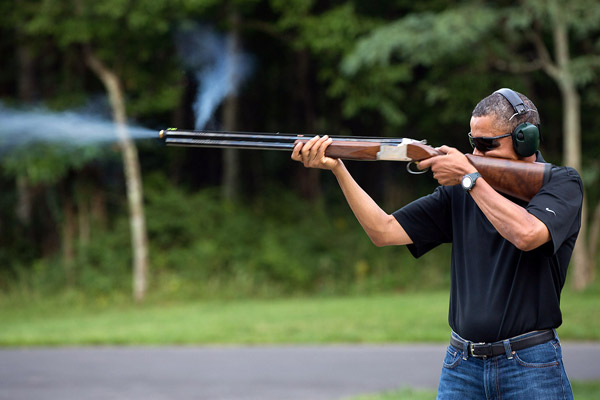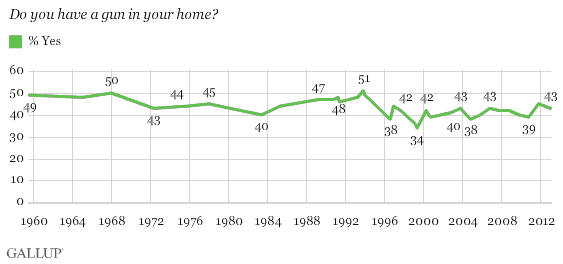
Photograph: The White House
On Saturday, the New York Times ran a piece indicating that, based on the General Social Survey (run by the University of Chicago's National Opinion Research Center), gun ownership in America was at historically low levels; because there's no national gun database, the NORC findings are generally relied upon by researchers:
The household gun ownership rate has fallen from an average of 50 percent in the 1970s to 49 percent in the 1980s, 43 percent in the 1990s and 35 percent in the 2000s, according to the survey data, analyzed by The New York Times.
In 2012, the share of American households with guns was 34 percent, according to survey results released on Thursday. Researchers said the difference compared with 2010, when the rate was 32 percent, was not statistically significant.
The findings contrast with the impression left by a flurry of news reports about people rushing to buy guns and clearing shop shelves of assault rifles after the massacre last year at an elementary school in Newtown, Conn.
Because of that contrast, I decided to poke around the numbers a bit. And there's definitely a contrast with the most recent numbers from Gallup, which has been tracking the question for years:

What's the deal? The two measures do essentially agree on one point: "A clear societal change took place regarding gun ownership in the early 1990s, when the percentage of Americans saying there was a gun in their home or on their property dropped from the low to mid-50s into the low to mid-40s and remained at that level for the next 15 years."
Emphasis mine: that language is really important and explains a lot about the competing claims. The difference between "do you own a gun" and "is there a gun in your home" is significant. Though the data isn't as fine-grained as anyone would like, the two trends—a decline in households with guns and a rise in gun sales (or at least not a drop; the data's more murky on this) can be squared.
The first evidence comes from a 2007 study, one of the more full-bodied studies of gun ownership in America, "The US gun stock: results from the 2004 national firearms survey." For instance: "Almost half (48%) of all individual gun owners, corresponding to 13% of the US adult population, reported owning 4 firearms. Household ownership followed a similar pattern, with 41% of firearm‐owning households reporting ownership of 4 firearms (table 22).). The 20% of gun owners who owned the most guns possessed about 65% of the nation's guns."
Put another way: 13 percent of individuals in the United States own four or more guns. The percentage that own one, two, or three? Six, four, and three. Men who have guns in the household have an average of 7.9 (!) and a median of five—so there are a lot of heavy gun owners throwing the average well above the median. The average among people with four or more guns is 12. In almost every (male) demographic, "owns both handguns and long guns" leads among gun owners, save for the under-25 set, where the ownership of long guns only is about the same.
Women are far less likely to own guns; they're even less likely to report the existence of a firearm in the home. So another explanation gets buried in the NYT piece: "While the rate of gun ownership among women has remained relatively constant over the years at about 10 percent, which is less than one-third of the rate among men today, more women are heading households without men, another possible contributor to the decline in household gun ownership." Only 12 percent of unmarried women own guns, according to the 2007 study, with an average of 2.5 guns and a median of two. Not that many single women own guns, and the ones that do don't own that many.
This is something that's come up before (PDF): "Since 1980 the household gun prevalence in the United States has trended down, while the prevalence of individual ownership has been close to constant. The explanation for the difference in trends is in the downward trend in the size of households, and in particular the percentage of households that include a man." If a man owns guns and gets divorced, for example, one household becomes two without doubling the number of guns.
The NYT story also buries another good explanation: "The increase of Hispanics as a share of the American population is also probably having an effect, as they are far less likely to own guns. In the survey results since 2000, about 14 percent of Hispanics reported having a gun in their house." There are 35 million more white people now in America than there were in 1980; they also made up the lowest percentage of the population in American history.
All put together, these seemingly intractable trends (evidence of increased gun sales, evidence of decreased household gun ownership) make more sense than at first glance. There are still plenty of white men around to buy weapons—but as heads of household and Americans in general, they make up a smaller percentage of the country than they used to. When you see something like "gun ownership is in decline in America," keep in mind how that's measured. The drop might reflect "a waning culture of guns and violence in the United States"—but it also reflects broader changes in American culture that have nothing to do with guns, but change the percentages.



